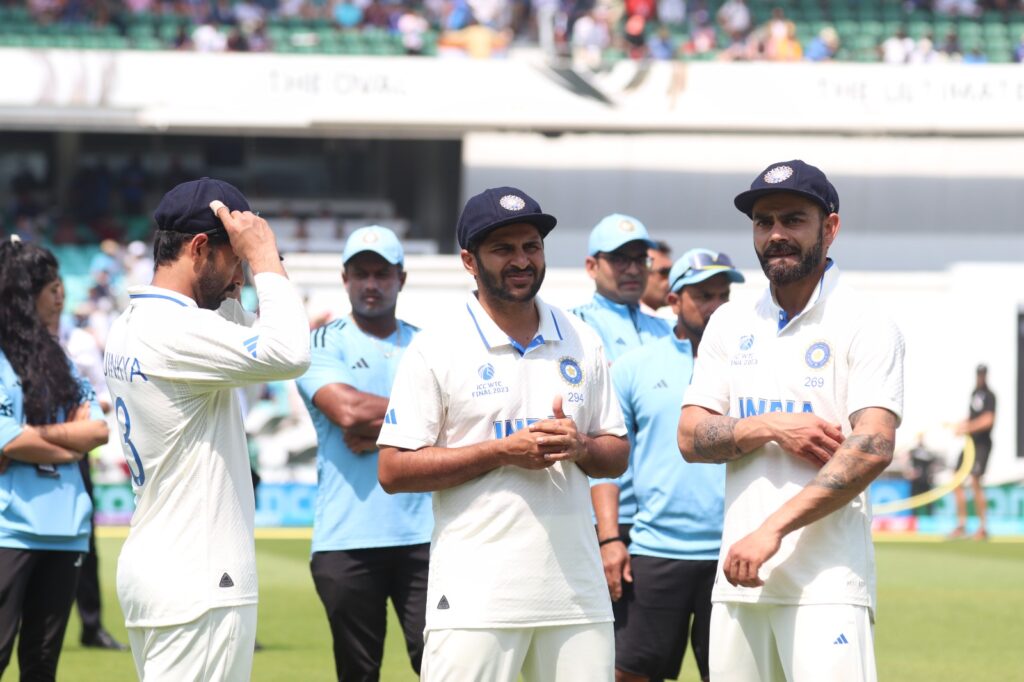
India have just lost a high-stakes final, in pretty miserable fashion. But the question to ask is why this happens repeatedly? Why is it that India continue to underperform in the big games?
A deep dive into India’s Test performances in the last three years throw up some key findings. Repeatedly, the opposition tail has hurt India. On Saturday, when Marnus Labuschagne was out to Umesh Yadav, Australia were 124-5, and India had a sniff. Had the tail been snuffed out for another 50 or 75 runs, India would have been chasing 375 and not 444. Despite having a well-rounded bowling attack, India could not polish off the lower order and ended up conceding valuable runs, which in turn proved decisive yet again. Sam Curran hurt India in England in 2018, Kyle Jamieson hurt them in New Zealand in 2020, and both Jamieson and Southee did so in the World Test Championship final in 2021. On day four at The Oval, it was Mitch Starc.
Had India managed to bowl Australia out for 200, the outcome could have been different. However, what-ifs don’t make history. Ground realities do. And the reality is that India weren’t able to close out the innings. For some reason or the other, the bowlers faltered in the home stretch. Somehow, somewhere, India are going wrong. We need a plan, and urgently.
The second point that we need to make is that our top order isn’t making a telling contribution. In the final, none except Ajinkya Rahane scored more than 100 runs in the game. And the manner in which some of the batters got out was even more disconcerting. Cheteshwar Pujara played an uncharacteristic ramp shot, which he hardly ever plays. Rohit Sharma played a needless sweep. Virat Kohli, who everyone was banking on, played with hard hands. So what’s the way forward to remedy this? While this will not be needed in Indian conditions, for overseas situations – India play Australia in Australia in 2024, and England in England in 2025 – we need a much better top-order effort to stay competitive.
Also Read: Australia Blow India Away on Final Day of WTC Final
The only option is a more fundamental rethink. While India now has a huge number of options to choose from in the white-ball formats, that isn’t the case yet with India’s batting in Test matches overseas. We don’t really have back-ups for our key batsmen. Who replaces Pujara at No. 3, for example, when he finishes a fantastic career? While Pujara has been an emblem of valour and courage, can he recalibrate his batting one final time to help the team cause?
The feature of this Indian team in Australia 2021 was its boldness. It was a brave decision to play Ravindra Jadeja in Melbourne ahead of a batsman, and he stood up to the challenge and made it count. His all-round ability proved to be an asset, and his improved batting skills meant we did not miss a batter. Did India miss a trick by playing four pacers at The Oval? Was it a defensive act to play both Umesh and Shardul Thakur? Did the team management err on the side of caution, and go against their own philosophy of aggressive cricket?
In sport, the best challenge themselves every single day. Roger Federer, for example, was still pushing his 40-year-old body to try and play one more season. The hunger was relentless, and that’s what made him the greatest champion of all. That’s what we expect from Rohit and Kohli and this team. Just like India reinvented the wheel after the 2019 World Cup semifinal and built a white-ball team that could play in any conditions with freedom and intent, we need the think-tank to do the same for Test cricket.
We need back-ups for every position, men who will be ready to take on the mantle when the time comes. It is fair to say that both Mohammed Shami and Umesh are in the home stretch of their careers. Both great servants of the game, they aren’t expected to be around when the next WTC final comes up. We need Mohammed Siraj, Shardul, Prasidh Krishna, Avesh Khan, Arshdeep Singh, and the next lot to be ready to take control when the baton eventually passes.
That’s what the process is all about. And that’s how you will keep knocking on the door, and be there or thereabouts. For 20 years, New Zealand persevered. Kane Williamson kept challenging his boys to stand tall and, in doing so, discovered match-winners like Kyle Jamieson. For years, Australia wanted to get back to the top of the world in red-ball cricket. For them too, it has been a process. And that’s what India need to emulate and learn from. And needless to say, take some bold calls.
Also Read: Conservatism and too much Rope – The Anatomy of a WTC Final Debacle




